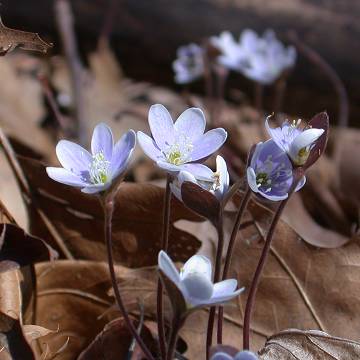

Hepatica americana - (image 1 of 7)
Taxonomy
Family: Ranunculaceae
Habitat
Woodlands, generally in more acidic conditions than H. acutiloba. Dune slopes, leached soils of slopes and ravines.
Associates
Sometimes found with H. acutiloba. On dune slopes found with Hamamelis virginiana, Quercus valutina, Rosa carolina, Sassafras albidum, Smilacina racemosa, Trillium grandiflorum, Vaccinium pallidum, Viburnum acerifolium.
Distribution
Most of the eastern half of the US and in a few states where H. acutiloba is not found.
Morphology
Low herbaceous perennial. Leaves basal, tri-lobed; lobes subrotund, obtuse, the angles broadly rounded. Flowers white, or pink to pale blue, petals absent, sepals 6 to 10, floral bracts typically 3. Stems hairy
Notes
Flowers mid March to mid May
Wetland indicator: Upland
One of the first woodland plants to bloom in spring, the little blue or white flowers stand out amongst the leaf litter. It blooms at a time of year when the lighting tends to be perfect for photography. Some authorities call this plant Hepatica nobilis Schreb. var. obtusa (Pursh) Steyermark, believing that our plants are not distinct from the European H. nobilis.
References
Swink, F. and G. Wilhelm. 1994. Plants of the Chicago Region.
Indiana Academy of Science. The Morton Arboretum. Lisle, Illinois.
|
Michael Hough © 2005 |